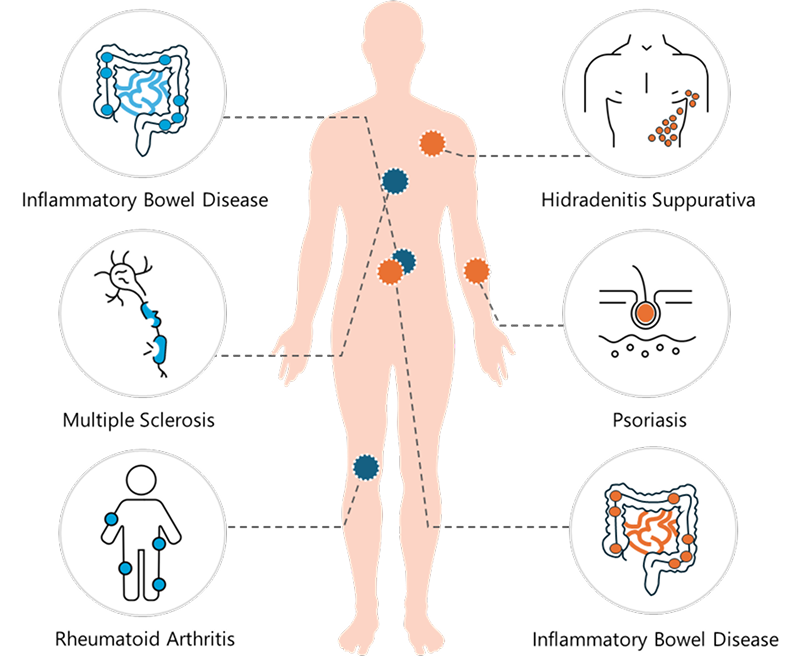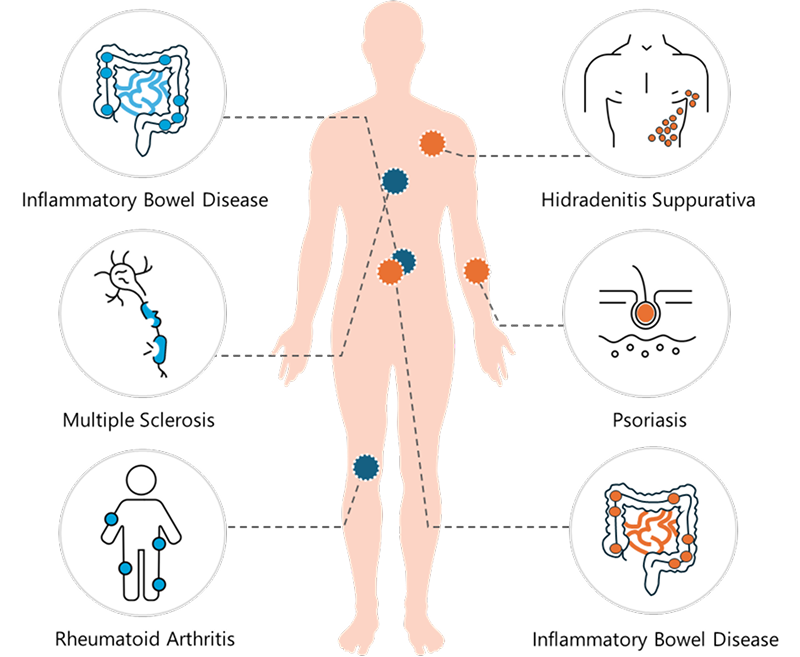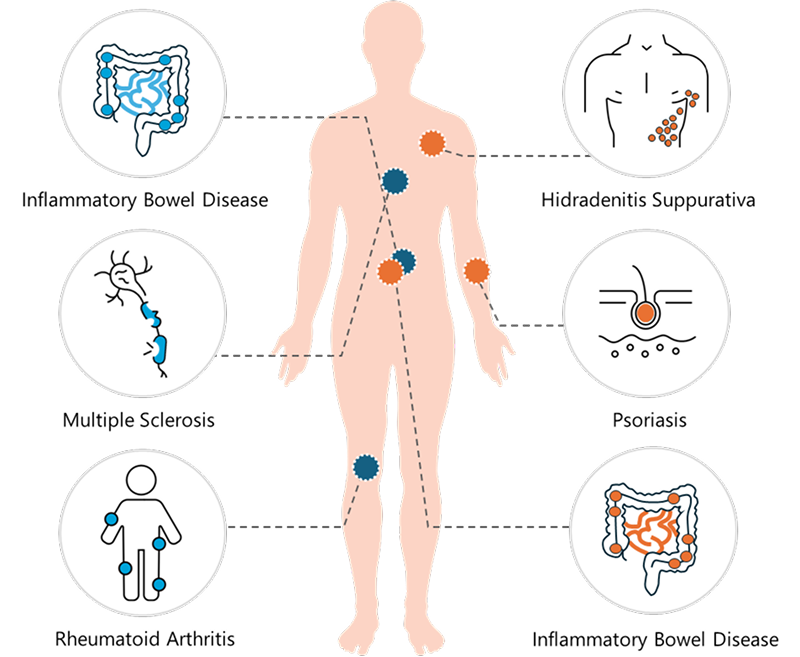Focus Areas
Overview

1) First-in-class 2) Best-in-class 3) GLP stage 4) non-GLP stage

1) First-in-class 2) Best-in-class 3) GLP stage 4) non-GLP stage
Small molecule
- · CR-C003 Small Molecule 1),3)

Multi-target Proteins
- · CR-T1~4 Therapeutic
Proteins 1),2),4) - · CR-T2-T4, CR-T2-T6
Therapeutic Protein 1)
1) First-in-class
2) Best-in-class
3) GLP stage
4) non-GLP stage
Autoimmune Disease
-
The unmet need
- · Autoimmune disease occurs when our immune system attacks our body, resulting in weakened physical abilities that could threaten our lives.
- · The cause and mechanism of autoimmune disease remain unclear. Thus, fundamental treatments for this disease are discovered yet.
- · At the moment, autoimmune disease patients are being prescribed with drugs that repress excessive inflammation or Th17 immune response. However, many patients do not respond to such drugs. In addition, drugs do not have a long-term efficacy due to anti-drug antibody responses.
-
Our approach
- · Curogen has been discovering small molecule compounds as drug candidates for treating autoimmune diseases by selectively inhibiting a novel therapeutic target molecule.
- · These candidates can efficiently restrict inflammatory reactions and Th17 immune responses, thereby immensely improving immune imbalance of autoimmune diseases such as psoriasis and inflammatory bowel disease.
- · While other antibody treatments use single molecule targeting strategies that are insufficient, Curogen’s unique platform technology includes dual and triple molecular target proteins for treating diseases with excellent therapeutic efficacy.
- · Our therapeutic proteins can efficiently improve anti-drug antibody responses than other existing antibody treatments.
- · Disease indication of each therapeutic protein will be classified on a medical and experimental basis.
Nonalcoholic Steatohepatitis (NASH)
-
The unmet need
- · NASH is liver inflammation and damage characterized by fat accumulation, lobular inflammation, hepatocyte ballooning, and fibrosis.
- · Severe fibrosis (Stages 3 and 4) is irreversible and serious because it can progressively develop into cirrhosis and hepatocellular carcinoma.
- · So far, there are no authorized treatments for NASH. Most treatments do not effectively restrict fibrosis.
- · Current treatments in development are targeting PPAR, FXR, CCR2/CCR5, GLP-1 and ACC. However, these treatments restrict hepatocyte lipotoxicity, liver metabolism, and immune response, which have limits for treating severe NASH.
-
Our approach
- · Curogen has secured a gene therapy candidate expressing a novel target molecule. It has been proved to have efficient treatment results for NASH in animal models.
- · The candidate will be developed with safety-proven recombinant serotype virus vectors in clinical trials for our NASH treatments.
- · Moreover, Curogen is developing drug candidates that can inhibit dual targets based on Curogen’s unique platform technologies of therapeutic proteins.
- · Curogen has also discovered additional novel therapeutic targets called CR-T5~8 for the development of drug candidates to treat NASH by alleviating fibrosis and controlling NASH microenvironment.
Hepatocellular Carcinoma (HCC)
-
The unmet need
- · HCC is the most common type of primary liver cancer. HCC occurs most often in people with chronic liver diseases such as hepatitis B or hepatitis C infection, alcoholic liver disease, and nonalcoholic fatty liver disease.
- · If HCC is diagnosed early, it can be treated with surgery to remove the cancerous tumor or with a liver transplant.
- · Other treatments such as hepatic artery chemoembolization have high recurrence rates. Most anticancer treatments used for systemic chemotherapy have low response rates, high tolerance rates, and serious side effects.
-
Our approach
- · Our recombinant gene therapy candidate has been developing in combination with conventional chemical anticancer drugs for a novel molecular target for HCC, which can suppress HCC, recover hepatocyte functions, and reduce liver damage.
B-cell Lymphoma
-
The unmet need
- · Most B-cell lymphomas are non-Hodgkin lymphomas that originate in B-cells. There are many subtypes of non-Hodgkin lymphomas, including diffuse large B-cell lymphoma (DLBCL), follicular lymphoma, CLL/SLL, and mantle cell lymphoma. DLBCL is the most common type of non-Hodgkin lymphoma worldwide, representing approximately 30-40% of all cases.
- · Treatment for B-cell lymphoma is similar to treatment for other types of non-Hodgkin lymphoma. Most often, the treatment is chemotherapy usually with a regimen of 4 drugs known as CHOP (cyclophosphamide, doxorubicin, vincristine, and prednisone) plus anti-CD20 monoclonal antibody rituximab (R-CHOP). However, these treatments have limits due to high non-response rates, high recurrence rates, and several side effects.
-
Our approach
- · Curogen has been developing small molecule compounds for a promising novel therapeutic target that can significantly increase cytotoxicity and effector functions of anti-tumor CD8+ T lymphocytes.
- · Our small molecule compounds are being developed in combination with CHOP treatment.
